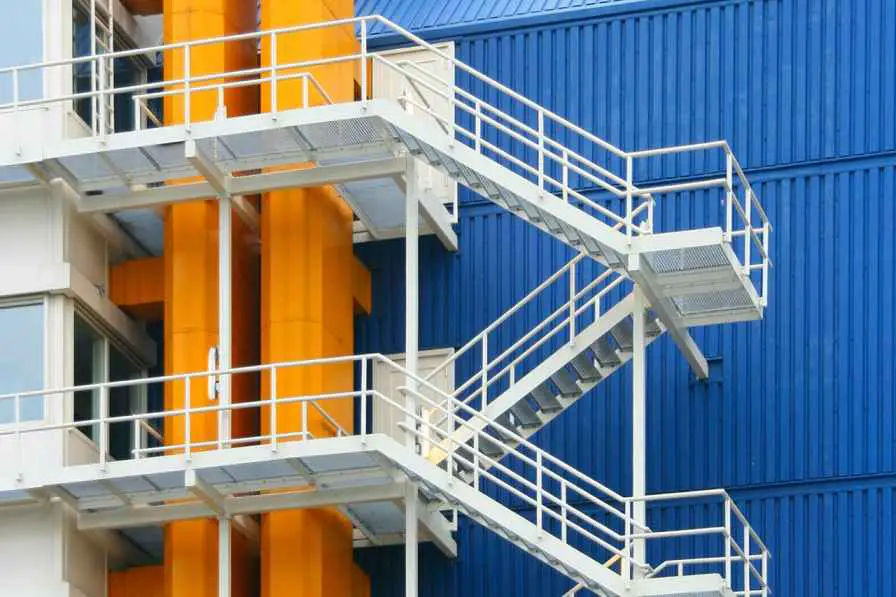Fire exit stairs or staircases were installed to help people to the lowest floor as quickly as possible.
The existing materials of different kinds, both horizontal and vertical are transported to the structure.
During an emergency, this staircase is essential for both commercial and residential structures within multiple stories structure.
In this article you’ll learn:
- Purpose of the Fire exit stairs.
- Types of Fire exit stairs.
- Merits and Demerits of the Fire exit stairs.
- Lots more.
So, if you’re ready to learn about Fire exit stairs this article is for you.
Let’s begin!
What are Fire Exit Stairs?
The fire escape staircase is a unique kind of emergency exit that is essential for a safe exit from the building in case of fire or another emergency.
In multi-story residential structures and commercial buildings, fire escape staircases are frequently used.
A fire escape stairway should be included in every structure to allow inhabitants to leave safely in an emergency.
Construction of the fire escape should be done with non-combustible materials.
Purpose of Fire Exit Stairs:
- High-rise buildings frequently have fire escape staircases to enable resident departure.
- Every structure that is built should abide by the minimum standards.
- When it comes to safety, a fire escape stairway is essential in multi-story buildings.
- They create fire escape staircases that are fire-resistant and complement the building’s interior design.

Types of Fire Exit Stairs:
1. Drop Ladder:
The drop ladder is a vertical ladder that is attached to the outside of the fire escape landing and lowers to the ground when triggered.
The most popular and secure piece of equipment that is frequently utilized in emergency situations is the drop ladder.
It is capable of being stable, fastened forever, and safe to use.
It is near the window so that emergencies may be handled immediately.
2. Counterbalanced Stairs:
The counter-balanced staircase is made up of a stairway that pivots and held in place by weights, which typically weigh several hundred pounds.
In an emergency, these stairs are frequently used.
During emergencies or in the event of a fire, building inhabitants may use these stairs.
3. Gooseneck Ladder:
These stairs are complicated and challenging to navigate.
The journey down to the bottom floor takes longer.
The bottom of this stair should be locked because it curves over the roofline.
Specifications for Fire Exit Stairs:
- The fire exit stair’s width shouldn’t be less than 0.7meters.
- The tread must be at least 15 cm wide.
- The height must not exceed 19 cm.
- Each flight of steps cannot have more than 16 risers.
- This kind of staircase’s landing should be at least 900mm long.
Regulations for Fire Exit Staircase:
There are specific references for fire escape stairs that are mentioned as follows:
- A tall structure should have no more than two fire escapes and staircases, and these should be connected to the common spaces and levels above ground.
- The fire escape staircase must not be counted while assessing the number of staircases for the structure.
- There shouldn’t be any obstructions in the way of the fire exit stairs
- A fireproof material should be used to make the door that leads to the fire exit staircases.
- The exit supplied to the fire must have a separate entry that is not connected to the internal stairway.
- Handrails on the fire exit staircases should be no higher than one meter.
- The location of the fire exit stairs should keep one side of the exterior wall that has a sizable exit opening.
- The diameter of the spiral fire exit staircases should be at least 1.5 meters, and there should be enough headroom.
- The ground must be directly linked to every fire exit stair.
- The main staircase and the fire escape steps must be one uninterrupted stairway from the bottom floor to the patio level.
- The fire exit staircase must have a straight run with a minimum width of 25 meters, 25 cm treads, and risers no higher than 19 cm.
- To reduce the occupant load and maintain a 9-meter building height, a spiral exit staircase should be supplied.
Advantages for Fire Exit Staircase:
- It can save a lot of people’s lives in urgent situations.
- It offers a fantastic way out.
Disadvantages for Fire Exit Staircase:
- The installation process takes additional time.
- More maintenance is necessary.
- They are extremely expensive.
- They are affected by rust, corrosion, rotting wood, broken mortar joints, separated welds, freeze/thaw cycles, carelessness, and poor maintenance.
Also read: Dog Legged Staircase | Types of Stairs | Stair Landing | Parts of stairs | Stair Stringer
Conclusion:
For new buildings in metropolitan areas, fire escape stairs are seen to be extremely crucial for fire protection.
In several locations such as schools, hotels, recreation facilities, etc. fire exit stairs available.

Related Posts
Rock Quality Designation(RQD): Building Strong Foundations
Spread Footing
Masonry Cement
Plain Cement Concrete
Concrete Efflorescence
Concrete Pile
Stepped Footing
Fineness Modulus of Coarse Aggregates
Difference between Condo and Apartment